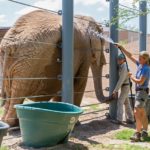Elephant Baby Blog
10/1/14 – Home Movies
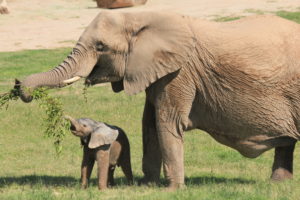 Zoo staff, like any proud parents, have been capturing Nandi’s adorable antics on video. Check out some of the best videos on our YouTube channel.
Zoo staff, like any proud parents, have been capturing Nandi’s adorable antics on video. Check out some of the best videos on our YouTube channel.
9-26-14 – Baby gets a Name
 Zoo fans were asked to vote on a name for the baby, and Nandi was the winner. Nandi (Nahn-dee), which is a common siSwati name for girls and means “sweet” or “fun” in the Zulu language. You can read more about the naming process, and about our fans’ reaction to the new name, in this article in the Arizona Daily Star.
Zoo fans were asked to vote on a name for the baby, and Nandi was the winner. Nandi (Nahn-dee), which is a common siSwati name for girls and means “sweet” or “fun” in the Zulu language. You can read more about the naming process, and about our fans’ reaction to the new name, in this article in the Arizona Daily Star.
9-22-14 Weighing In
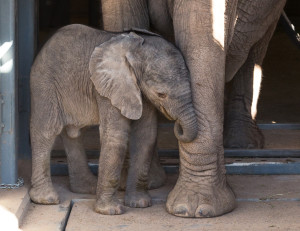 One of the best ways to make sure the elephant calf is growing up strong and healthy is to monitor her weight gain. There is a scale built right into the floor of the Elephant Care Center, and each day mom and baby walk over it to go outside into the yard. It’s not always easy to position the baby on the scale without mom, and for long enough to get an accurate weight on her, so some days the process takes longer than others. But as she becomes accustomed to the routine, it will get easier! When she was born, the baby weighed 245 lbs. As of Sunday, Sept. 21 (just a month after birth), she weighed 345 lbs. Can you imagine gaining 100 lbs in a month??
One of the best ways to make sure the elephant calf is growing up strong and healthy is to monitor her weight gain. There is a scale built right into the floor of the Elephant Care Center, and each day mom and baby walk over it to go outside into the yard. It’s not always easy to position the baby on the scale without mom, and for long enough to get an accurate weight on her, so some days the process takes longer than others. But as she becomes accustomed to the routine, it will get easier! When she was born, the baby weighed 245 lbs. As of Sunday, Sept. 21 (just a month after birth), she weighed 345 lbs. Can you imagine gaining 100 lbs in a month??
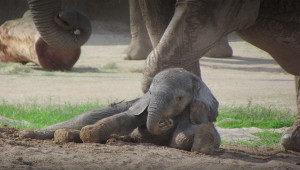 9-4-14 Milestones
9-4-14 Milestones
Zoo Keepers and interns have been tirelessly documenting our baby’s behaviors 24 hours a day. All these individual observations contribute to the elephant program here at Reid Park Zoo, as well as to the larger scientific community. It’s also fun to share some of the big milestones in the baby’s development. For example, she has mastered laying at the edge of her mud wallow, and in hardened mud. But if she gets too far into soft mud, she sometimes needs mom’s assistance to get out! She also looks up to her older brother, 3 year old Sundzu, and sometimes follows him around for short periods instead of mom.
8-23-14 Baby explores the yard
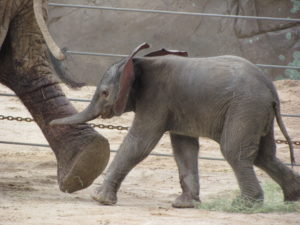 This morning Zoo Keepers decided that all the conditions were right to allow Semba and baby access to the far side of the exhibit for some sun and exercise. Keepers and interns watched carefully from all angles to make sure the baby was safe, and that all the other elephants were being gentle around the newborn. Everyone did great! A few lucky Zoo guests even got to see the baby from a distance, as mom and baby spent some time right up against the fence between the two yards. Keepers will continue letting the baby out into the far yard whenever they feel the time is right–mom needs to be relaxed, the rest of the herd needs to be calm, and the baby needs to be alert. She usually won’t stay out more than a couple of hours at most–remember that one lap around the far yard is a HUGE distance for a baby elephant. After some time in the yard she’s usually ready for a nap!
This morning Zoo Keepers decided that all the conditions were right to allow Semba and baby access to the far side of the exhibit for some sun and exercise. Keepers and interns watched carefully from all angles to make sure the baby was safe, and that all the other elephants were being gentle around the newborn. Everyone did great! A few lucky Zoo guests even got to see the baby from a distance, as mom and baby spent some time right up against the fence between the two yards. Keepers will continue letting the baby out into the far yard whenever they feel the time is right–mom needs to be relaxed, the rest of the herd needs to be calm, and the baby needs to be alert. She usually won’t stay out more than a couple of hours at most–remember that one lap around the far yard is a HUGE distance for a baby elephant. After some time in the yard she’s usually ready for a nap!
8-21-14: Watch a video of the baby
Elephant calves are up and walking around within an hour of birth, but it takes a little while for them to gain confidence. The video linked below shows the baby walking around in the barn at about 12 hours old.
Unsteady Legs
8-21-14: It’s a GIRL!
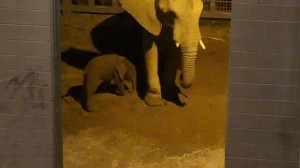 The baby is herel!!! Semba delivered a female calf at 10:55pm on August 20, 2014, after being in labor for only 20 minutes. The calf hit the ground at exactly 10:55pm, took a first breath immediately, stood up within minutes, and began to nurse within the hour. The calf weighs 245lbs but has not been named yet.
The baby is herel!!! Semba delivered a female calf at 10:55pm on August 20, 2014, after being in labor for only 20 minutes. The calf hit the ground at exactly 10:55pm, took a first breath immediately, stood up within minutes, and began to nurse within the hour. The calf weighs 245lbs but has not been named yet.
The first 48-72 hours following the birth are the most essential for Semba and her calf to form a strong physical and emotional bond. Absolutely no visitors or non-essential staff members are being admitted to the Elephant Care Center at this time. Once the calf is nursing regularly and following Semba instinctually, additional areas of the holding facility will be opened for them to explore. Keepers will also be watching to make sure Semba is eating, drinking, and recovering normally from the physical stresses of labor. As the calf gains strength, she will be introduced to the rest of the herd.
Watch this page for frequent updates as well as additional photos and video, which we’ll share as they become available. Congratulations Semba!
8-5-14: A High-Tech Endeavor
 Our dedicated interns are in their fourth week of 24-hour baby watch–which means when you’re home in your comfy bed, they’re camped out in the Elephant Care Center watching Semba for any signs of impending labor. How do you watch an elephant in the dark? With night vision mono-goggles, of course! This allows our interns to observe the elephants without disturbing them. This piece of equipment, generously donated to the Zoo from Semba’s wish list, will be helpful not just during Semba’s pregnancy, but long after the baby is born. We will continue our overnight watch until Keepers determine the baby is old enough to spend the night unsupervised by staff.
Our dedicated interns are in their fourth week of 24-hour baby watch–which means when you’re home in your comfy bed, they’re camped out in the Elephant Care Center watching Semba for any signs of impending labor. How do you watch an elephant in the dark? With night vision mono-goggles, of course! This allows our interns to observe the elephants without disturbing them. This piece of equipment, generously donated to the Zoo from Semba’s wish list, will be helpful not just during Semba’s pregnancy, but long after the baby is born. We will continue our overnight watch until Keepers determine the baby is old enough to spend the night unsupervised by staff.
 7-31-14: Still waiting….
7-31-14: Still waiting….
Although Semba is still in a very normal window for giving birth, everyone is anxious for the baby to arrive. Check out this story by the AZ Daily Star online for answers to the questions we’ve been hearing a lot lately.
7-15-14: Semba gets a Shower
Keepers are working hard to keep Semba as comfortable as possible in the late stages of pregnancy. In the heat of summer, a nice cool shower is a great treat for Semba.
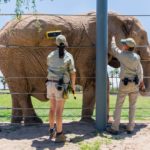 7-12-14: 24-hour Baby Watch is Underway
7-12-14: 24-hour Baby Watch is Underway
Here’s an update from Zoo Elephant Team Supervisor Sue Tygielski: “Trained interns and Zoo docents now keep an eye on Semba 24-hours a day, watching her and documenting her behavior wherever she goes. Semba continues to have access to the pool half of the exhibit during the day. She continues to interact with the calves and has started swimming more. She is spending her nights in the barn and paddock in the event that onset of labor occurs overnight. For now – we all continue to watch!”
 6-27-14: Semba, TV Star!
6-27-14: Semba, TV Star!
This morning Tucson News Now sent its KOLD News 13 and KMSB Fox 11 morning show crew to the Zoo to check in on Semba’s progressing pregnancy and chat with Zoo Elephant Team Leader Sue Tygielski. Semba and the rest of the herd did a great job of showing off their training behaviors on camera. The Zoo is gearing up for an Elephant Baby Shower to be held this Sunday, June 29th from 8-10am, and we’re hoping lots of Tucson’s residents come out to join us in celebrating Semba and her impending elephant baby!
6-13-14: Putting on Baby Weight

So far, Semba’s weight is right on target for a healthy pregnancy–last Sunday she weighed 7,600lbs. This Sunday, June 15th, Semba switches from weekly weigh-ins to daily ones. The last two months of an elephant pregnancy are the most significant in terms of weight gain. It is a critical time to be sure Semba continues to gain baby weight slowly, but not extra weight. Added weight can make delivery more difficult.
6-10-14: Baby Proofing Continues
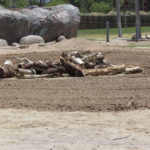 Elephant Keepers continue searching for spaces in the exhibit that might be dangerous for the little one–and it’s a big exhibit! When they find a space that doesn’t seem completely safe, they add sand, logs or other barriers to block it. Staff are also working on removing the abundance of large log piles from the exhibit and barn. While large logs in the exhibit are great to rub up against and search for food in and around – a pile of logs that are not secure could topple on or trap a baby elephant. The good news is the bears and cats in the zoo will get to play on some of the logs removed from the elephant exhibit!
Elephant Keepers continue searching for spaces in the exhibit that might be dangerous for the little one–and it’s a big exhibit! When they find a space that doesn’t seem completely safe, they add sand, logs or other barriers to block it. Staff are also working on removing the abundance of large log piles from the exhibit and barn. While large logs in the exhibit are great to rub up against and search for food in and around – a pile of logs that are not secure could topple on or trap a baby elephant. The good news is the bears and cats in the zoo will get to play on some of the logs removed from the elephant exhibit!
6-8-14: Semba goes Swimming
 Semba has finally taken the plunge! While she has never been much for swimming, over the weekend and continuing into this week days she has had a change of heart – we have found her bouncing in the pool and splashing at the stream. Since she seemed to be enjoying the water so much, her keepers took the opportunity to scrub her feet with a bubbly elephant wash – and a few quick trims on her toenails too.
Semba has finally taken the plunge! While she has never been much for swimming, over the weekend and continuing into this week days she has had a change of heart – we have found her bouncing in the pool and splashing at the stream. Since she seemed to be enjoying the water so much, her keepers took the opportunity to scrub her feet with a bubbly elephant wash – and a few quick trims on her toenails too.
6-4-14: A Big Ultrasound
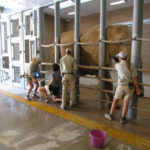 Many new parents anxiously await the day when they can see ten fingers and ten toes on an ultrasound image (as well as a possible determining sign of gender). As a part of Semba’s regular prenatal care, we perform trans-abdominal ultrasounds as well. Semba is trained to voluntarily stand still for the exam and allow the keepers and vet to rub gooey probe to her side with a gentle pressure.
Many new parents anxiously await the day when they can see ten fingers and ten toes on an ultrasound image (as well as a possible determining sign of gender). As a part of Semba’s regular prenatal care, we perform trans-abdominal ultrasounds as well. Semba is trained to voluntarily stand still for the exam and allow the keepers and vet to rub gooey probe to her side with a gentle pressure.
While thick skin and early gestational stage have prevented us from seeing toes, or even a trunk with this non-invasive procedure, our vet has detected a strong heartbeat. The veterinary team assures us that, so far, Semba and baby seem right on track for a normal pregnancy. The majority of fetus growth takes place at the end stage of pregnancy, so we will continue to perform ultrasounds with the hopes of reporting findings soon.
6-3-14: Baby Proofing
 Today crews are out once again working on baby proofing the elephant exhibit. The beautiful artificial rock work in the habitat has an area where a sliding gate recedes into the rock. The gap between gate and rock might be a bit big – posing a potential threat to a curious newborn elephant. Contractors are working to fill-in and secure the gaps.
Today crews are out once again working on baby proofing the elephant exhibit. The beautiful artificial rock work in the habitat has an area where a sliding gate recedes into the rock. The gap between gate and rock might be a bit big – posing a potential threat to a curious newborn elephant. Contractors are working to fill-in and secure the gaps.
While we have elephants off exhibit, we are taking advantage of this time to woodchip old branches in the yard that elephants are done eating (and playing with). We are also rototilling the yard – a chore we do regularly. By digging up the compacted dirt and “fluffing” it up, we ensure the elephant herd has access not only to a soft surface to walk on, but it’s also great enrichment for the elephants. The days after rototilling elephants explore, roll in the soft soil, and toss the fresh dirt on themselves. Who knew baby proofing could be so much fun!?
6-1-14: Preparation Ramps Up
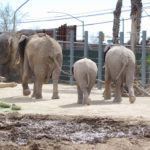 Although this is Reid Park Zoo’s first baby elephant, Semba has two older sons who were born at the San Diego Zoo Safari Park. Now seven and three years old respectively, Punga and Sundzu came to Reid Park with the rest of the herd in 2012, when Sundzu still really looked like a baby. Semba has been preparing for the new birth by gradually pushing Sundzu away to feed on his own, and encouraging him to play independently. As the matriarch in the exhibit, Semba has also continued to strengthen bonds with the herd through play and interaction. This ensures that she will have the support of Lungile (the other mature female in the herd), and the two young elephants after the new baby arrives.
Although this is Reid Park Zoo’s first baby elephant, Semba has two older sons who were born at the San Diego Zoo Safari Park. Now seven and three years old respectively, Punga and Sundzu came to Reid Park with the rest of the herd in 2012, when Sundzu still really looked like a baby. Semba has been preparing for the new birth by gradually pushing Sundzu away to feed on his own, and encouraging him to play independently. As the matriarch in the exhibit, Semba has also continued to strengthen bonds with the herd through play and interaction. This ensures that she will have the support of Lungile (the other mature female in the herd), and the two young elephants after the new baby arrives.

